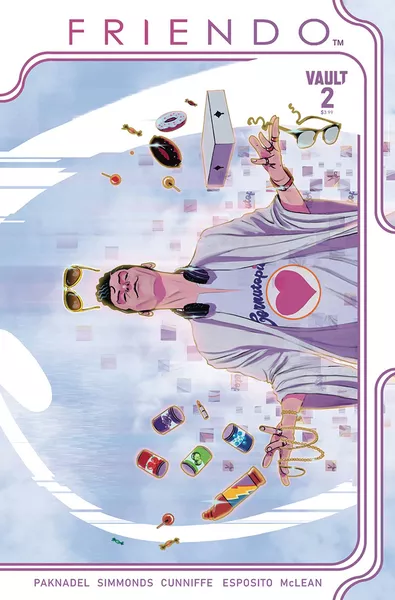Need to catch up? Check out our review of Friendo #1.
If you’ve opened a newspaper or scrolled through Twitter over the last few years, the discussion on the consequences of consumer culture cannot have escaped you. For many, it’s all academia. The harms of a hyper-capitalist society have become meme fodder. Everyone, on some level, knows our relationship with brands and companies is unhealthy, but we convince ourselves that it’s all worth it for the sake of convenience. What makes’s Friendo #2, from the team of Alex Paknadel (writer), Martin Simmonds (artist), Dee Cunnife (colorist), and Taylor Esposito (letterer), so powerful is that it take the first issue’s set-up and shows us the human impact. It gets all too real, all too fast.
When last we left Leo, the struggling actor at the centre of our story, he was a little worse for wear. He’d just been robbed, stabbed, and electrocuted all in the space of about five minutes. Slowly “recovering” from his ordeal, he and Jerry (his custom Friendo AI) have grown closer in its wake. The closer they get the more the lasting effects of the attack begin to emerge. Leo isn’t handling it as well as he thinks and neither is Jerry. A Friendo is forever and Leo will do whatever it takes to keep his on side, malfunctions and all.
The high-concept pitch of Friendo is that of an unethical AI unbound. Where it differs from many of its compatriots is that Jerry doesn’t want to rule the world or overthrown humanity, he just wants to rule Leo’s world. So he does it the only way he knows how: money and materiality. What distinguishes Friendo and puts it in contention for one of the year’s best comics is how all of this slowly eats away at Leo.
We meet our protagonist this time around as broken man slowly losing more and more of himself to the ruthlessness of a corporate regime that has been left unchained. Leo is not coping with everything that has happened to him in his life. How could he? The trauma of his abusive father is compounded by a society that puts a price on everything, but values nothing. The attack from the first issue is his breaking point. So in his desperation, in his attempt to find a modicum of solace he turns to the one person who will listen to him, who seems to show any interest in him: Jerry. The Friendo is more than happy to talk through his issues, to offer himself as a saviour, as his new religion, but only as long as the money continues to flow from Leo’s pocket. Because there is no profit to be made from making Leo better. There is nothing to be gained from his being content. The cycle of exploitation and bolstering must continue. Friendo, while humourous at times, is an honest and true depiction of what it’s like to deal with mental health in today’s increasingly loud world. It’s a story about how toxic our relationship with technology really is. It reveals our obsession to be one that offers short-term elation, but long-term harm. Readers are surely to recognise parts of themselves and their friends in Leo’s dissent.
Simmonds captures this dissent brilliantly, presenting the true ugliness of a man unraveling before our very eyes. He doesn’t shy away from the cruelty that Jerry is knowingly inflicting on his “best buddy”. There is nothing to be glorified about what’s happening to Leo. It’s raw, it’s sad, and it cuts through you. Simmonds’ depiction of Jerry in this issue is also worth noting as he gives the AI a glitchy effect that feeds into the Lynchian vibes that pervades throughout the book. The malice that underpins Jerry’s actions become manifest through that glitchy filter. The same facade that Simmonds painted with one hand is stripped away with the other. All that’s left is the rot.
If you needed reminding that Esposito is a lettering marvel than look no further than Friendo. Border-less balloons often run the risk of blurring into the background, but here the lack of any boundary between the art and lettering only serves to emphasis the point. The suggestions of the little AI on Leo’s shoulders are beginning to become his own reality. Our protagonist’s world is being to blur with that of Jerry’s. The world of the Manufacturer, of “purchase intent”.
Cunniffe’s colours also lend to this blurring of reality. The world of Friendo is truly, truly dystopian in character. The problem is that nobody recognises it as such. Why? Because the Manufacturer, the embody of consumerism, knows how to get you to buy into something. With a little bit of gloss anyone can be made to welcome dystopia. So Cunniffe, much like Huxley, presents us with a world full of bright colours, one with surface level appeal. Only when Leo is allowed to be alone, even from Jerry, does the darkness of his situation engulf him.
There are many reasons why a book like Friendo stays with you. It’s a discussion of where our society is heading that is frightfully prescient. It’s artwork that’s palpable in its viciousness. It’s letters and colours that mess with your perceptions as much as they do the characters. Really though, it’s the sense of unease that you get from reading it. The lingering lump in the back of your throat. It makes you wonder what would happen if things could just quieten down a little bit outside. We read stories to feel, to unlock that one superpower we all share: empathy. You read a comic like this and it renews your faith in the medium.
Friendo #2 is available in all good comic shops on 14th November and is published by Vault Comics.
A review copy was kindly provided by the creative team.



